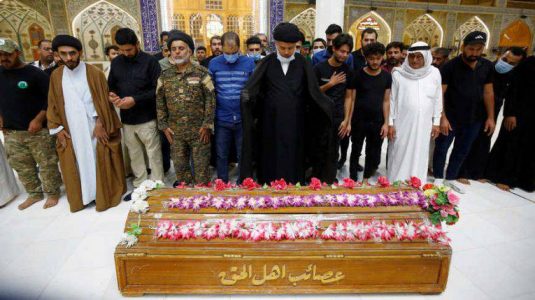
Islamic State terrorist group launch attacks in Iraq during Ramadan
The first of several Islamic State (IS) attacks in Iraq began just before suhoor on May 2, the meal of pre-dawn during the Muslim holy month of Ramadan before fasting, and lasted several hours, Salahuddin councilor Subhan Jiyad told Al-Monitor via WhatsApp later in the day.
Most of those killed were Sunni people from the Albu Issa tribe, according to another source who sent a list of the names of those “martyrs”.
This first of several attacks in the area over a 24-hour period occurred in Mukashifa, a city northwest of Samarra along the main road linking Baghdad and Tikrit. Samarra is a Sunni-majority city in central Iraq known for its Al-Askari shrine, as the Golden Dome Mosque, a place of pilgrimage for Shiite Muslims. The city is also the birthplace of former IS leader Abu Bakr al-Baghdadi.
“Six members of the local Popular Mobilization Units (PMU) were killed in the attack at a checkpoint,” added Councilor Jiyad. “Then, when reinforcements were sent, three more were killed by an improvised explosive device (IED) set up by IS.”
Another pre-dawn attack happened in Tal al-Dhahab in the Yathrib district southeast of Samarra.
The two attacks killed a total of 11 PMU fighters, Al-Monitor was told by a fighter previously deployed to the area with Saraya al-Salam establishing a comprehensive network of contacts in the area maintains.
The Yathrib district is in Salahuddin, but borders the province of Diyala, which has seen an uptick in attacks in recent months and which extends from the north and east of the capital to the Iranian border.
Capt Isser Ali Rabea al-Azzawi, a border police officer, was killed at his home in Yathrib on April 30, also reported by IS.
After iftar on May 2, post-mortem just after sunset, there were other attacks in Salahuddin Province. No victims were reported.
IS fighters then tried to approach Karbala from the direction of the southern city of Anbar, al-Nukhyab, which lies between the Saudi border of Iraq and the city revered by Shiite Muslims for its sacred shrines and historical interest, but were pushed back by PMU linked to the shrines.
In Diyala, there was an IED attack on a military car post-iftar that resulted in one death, while three police officers were shot and killed and two others were injured in an IS attack on a police station in al-Abara area of the regional capital of Baqubah.
The flurry of attacks was accompanied by first inflated numbers of accidents for those who happened and reports of other incidents that had never happened, such as rumors of someone in Isahaqi on May 2.
Iraqi security expert Hisham al-Hashimi noted in a tweet that the apparently coordinated attacks serve to boost media coverage for the international terrorist group, and that “takfiri groups” hold Ramadan of special interest in fighting operations.
Meanwhile, several Iran-linked PMUs, as long as they have, claimed that the United States IS “helping” and that recent attacks prove this.
The PMU had even more strongly demanded that all foreign troops leave the country after the US drone strike on Kataib Hezbollah commander Abu Mahdi al-Muhandis and Iranian Gen. Qasem Soleimani on January 3 at Baghdad airport. Members of Parliament were probably warned to vote in favor of a parliamentary resolution calling for this withdrawal or burden of unspecified consequences.
Following a suicide attack on Kirkuk intelligence agencies on April 28, a provincial MP warned that international coalition intelligence had previously served to prevent such attacks, but that there is now a lack of such support following their withdrawal from a base in the area in late March.
In Salahuddin, local troops received factions backed by Iran when US military aid first failed to materialize in the immediate wake of IS taking over a large part of the province in 2014. The face of Kataib Hezbollah commander Abu Mahdi al- Muhandis, killed by a US drone strike on January 3 at Baghdad airport, has long figured heavily on billboards in the entire province.
Meanwhile, coalition airstrikes continue to target IS in Iraq. On April 25, Britain announced that it had launched its first anti-IS airstrikes in seven months on April 10, near Tuz Khurmato in Kirkuk Province. International Coalition spokesman Col. Myles B. Caggins III tweeted April 30, “Bombs away!” – link to a video showing what he said was an air strike on the Hamreen Mountains the previous day.
Salahhuddin regional council chairman Ahmed al-Krayem told Al-Monitor in a WhatsApp exchange in the early morning of May 3 that the previous day’s attack was “a reaction” from IS to a ” airstrike a week ago 15 IS (fighters) and two IS leaders were arrested – one a Turkish national and the other from Mosul, “adding that the area” has always been a target of terrorism “because of its geographical position which the eastern and western parts of the country connected.
Krayem added, “There have been problems between the Albu Issa tribe and IS (i.e. its predecessors) since 2007, when the tribe attacked al-Qaeda and killed some (of them).”
He claimed that these attacks simply “strengthened Albu Issa’s resolve to fight IS.”
The opinion that the refurbishment in attacks is a reaction to stronger action against IS concealment and remains would seem to coincide with that proposed by Caggins, who on April 26 had told Al-Monitor that greater activity by IS was partly ” because of Iraqi security forces direct action against Daesh (IS) shelters in mountainous regions and rural areas in north central Iraq. “
However, the magnitude and apparently coordinated nature of the attacks may point to an attempt at resurrection amid a continuing government space and suffering problems between the Kurdistan Regional Government and the central government in Baghdad.
Source: The Media Hell





